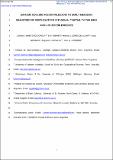Jurassic cooling ages in Paleozoic to early Mesozoic granitoids of northeastern Patagonia : 40Ar/39Ar, 40K–40Ar mica and U–Pb zircon evidence
Abstract
U–Pb SHRIMP zircon crystallization ages and Ar–Ar and K–Ar mica cooling ages for basement rocks of the Yaminué and Nahuel Niyeu areas in northeastern Patagonia are presented. Granitoids that cover the time span from Ordovician to Early Triassic constitute the main outcrops of the western sector of the Yaminué block. The southern Yaminué Metaigneous Complex comprises highly deformed Ordovician and Permian granitoids crosscut by undeformed leucogranite dikes (U–Pb SHRIMP zircon age of 254 ± 2 Ma). Mica separates from highly deformed granitoids from the southern sector yielded an Ar–Ar muscovite age of 182 ± 3 Ma and a K–Ar biotite age of 186 ± 2 Ma. Moderately to highly deformed Permian to Early Triassic granitoids made up the northern Yaminué Complex. The Late Permian to Early Triassic (U–Pb SHRIMP zircon age of 252 ± 6 Ma) Cabeza de Vaca Granite of the Yaminué block yielded Jurassic mica K–Ar cooling ages (198 ± 2, 191 ± 1, and 190 ± 2 Ma). At the boundary between the Yaminué and Nahuel Niyeu blocks, K–Ar muscovite ages of 188 ± 3 and 193 ± 5 Ma were calculated for the Flores Granite, whereas the Early Permian Navarrete granodiorite, located in the Nahuel Niyeu block, yielded a K–Ar biotite age of 274 ± 4 Ma. The Jurassic thermal history is not regionally uniform. In the supracrustal exposures of the Nahuel Niyeu block, the Early Permian granitoids of its western sector as well as other Permian plutons and Ordovician leucogranites located further east show no evidence of cooling age reset since mica ages suggest cooling in the wake of crystallization of these intrusive rocks. In contrast, deeper crustal levels are inferred for Permian–Early Triassic granitoids in the Yaminué block since cooling ages for these rocks are of Jurassic age (198–182 Ma). Jurassic resetting is contemporaneous with the massive Lower Jurassic Flores Granite, and the Marifil and Chon Aike volcanic provinces. This intraplate deformational pulse that affected northeastern Patagonia during the Early Jurassic (Sinemurian–Pliensbachian) was responsible for the partial (re)exhumation of the mid-crustal Paleozoic basement along reactivated discrete NE–SW to ENE–WSW lineaments and the resetting of isotopic systems. These new thermochronological data indicate that Early Permian magmatic rocks of the Nahuel Niyeu block were below 300 °C for ca. 20 Ma prior to the onset of the main magmatic episode of the Late Permian to Triassic igneous and metaigneous rocks of the Yaminué block.
Citation
Martínez Dopico , C I , Tohver , E , López de Luchi , M G , Wemmer , K , Rapalini , A E & Cawood , P A 2017 , ' Jurassic cooling ages in Paleozoic to early Mesozoic granitoids of northeastern Patagonia : 40 Ar/ 39 Ar, 40 K– 40 Ar mica and U–Pb zircon evidence ' , International Journal of Earth Sciences , vol. 106 , no. 7 , pp. 2343-2357 . https://doi.org/10.1007/s00531-016-1430-0
Publication
International Journal of Earth Sciences
Status
Peer reviewed
ISSN
1437-3254Type
Journal article
Description
University of Buenos Aires (PICTUBACYT X183), CONICET and ANPCYT (PICT20131162) financial support is acknowledged.Collections
Items in the St Andrews Research Repository are protected by copyright, with all rights reserved, unless otherwise indicated.

